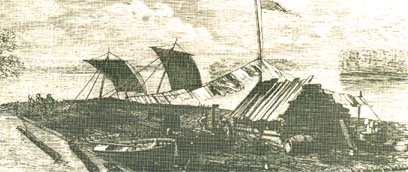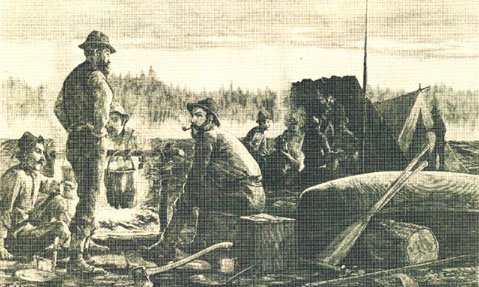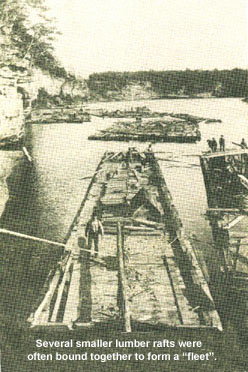LUMBER RAFTING ON WISCONSIN RIVER |
|
|
It was in 1849 that I made my first trip down Wisconsin River. April 7 of that year, my cousin and I went up to the Big Eau Claire, and began running lumber over the dam. The white and Norway pine of the Wisconsin pinery was, as a rule, cut into logs sixteen feet long, which were made into lumber at the neighboring mills. This lumber was then rafted to market.
The making of a raft. The raft was made by taking three planks and boring two-inch auger holes about one foot from each end and another in the middle. Into these holes grubs were inserted. These grubs were small trees about two inches in diameter, dug up with a portion of the roots, and cut off about three feet above and made to fit the holes with a head upon tl'e lower end. After the grubs are fitted into the plank, three boards (the same as the grub planks) were put upon the grubs crosswise. Then the raft-building commenced, the lumber being put on crosswise alternately, until sixteen courses were laid. Then binding planks were fastened on to the grubs, and witched or drawn tight together with an instrument called a witch, and then wedged fast. This formed what was known as a crib, and contained about 4,000 feet of lumber. Six or seven of these cribs were put together, one in front of the other, and fastened by coupling planks A head-, and a tail-block were put on and very strongly fastened, to which were attached oars, each made of a plank sixteen feet long and about eighteen inches wide, about two and one-fourth inches thick at one end, and three-fourths of an inch at the other. This oar was fastened to an oar-stem, which was from thirty-six to forty feet long. This made an oar from fifty to fifty-six feet in length, that was used to guide the raft. Six or seven cribs fastened in this wise were known as a "rapids piece," because in this condition they can be run over rapids and through swift water. Two or more of them make what is called a "Wisconsin raft," and several of those rafts comprise a "fleet of lumber." Frequently the lumber raft gets the advantage of the person running it, and passing under leaning trees sweeps him off into the river. I was thus served on the Eau Claire. While at the head of Little Bull Falls (April 15), I accidentally fell in again. In passing over the falls at the "Jaws," I came very near being knocked overboard by the oar getting away from the steersman. No one thus thrown off at this place has been known to have been saved. A rafting trip. We passed on down (April 20) to Stevens Point and Conant Rapids. On the 21st we stopped at the Yellow Banks, near Plover, and later were caught on Crooked Riff. We next passed on to Grand Rapids, where three men were drowned. May 1, our run was from Grand Rapids to Pointe Bas, over the Whitney Rapids, which are the lowest on Wisconsin River. On the 6th we saw millions of pigeons, and passed the Roche a Cri flats. Such flats occur usually at the mouth of some affluent, where the river spreads out very wide and the water is so shallow that at a low state it is difficult to raft the lumber over. About sundown on the
same day we passed through the Dells. The raft ahead of ours struck Notch
Rock, and turned a whole rapids piece bottom side up, breaking it to pieces. The great river, which at some places is half a mile wide, at this point is narrowed down to fifty-four feet, with a rapid current. There is an eddy formed by a rock, which is liable to catch the bow of a raft, and owing to its great velocity dash it against a notch in a projecting rock. Just below this is a bridge which spans the gulf, sixty feet in width, at a height of seventy feet above the water. Directly below the bridge is a sharp bend in the river, which forms a powerful whirlpool or eddy. I have been through there on a lumber raft in high water, when the swirls looked as though they were ten feet deep, and when three oars out of four were unshipped or broken, and some portions of the raft would be three or four feet under water. The next bend below is called the Rainbow. Rafts were apt to run into it and strike the rocks very hard. Just below this stood the Dell House, where there was a good eddy to land lumber. After passing Kilbourn City and Newport, Sugar Loaf Rock appears, and farther down on the opposite side Lone Rock, a solitary pinnacle thirty or forty feet high, much dreaded by raftsmen, since the current sets strongly against it, and rafts were frequently driven to destruction there. This is at the foot of the Dells, which are five miles in length. From the Dells we passed
on by Norwegian Bluff, Pine Island, and Portage City; and still farther
down, Sauk Prairie. A few miles below this are the Ho We drifted on to the
bosom of the "Father of Waters" and connected our rafts together, thus
making what is known as a Mississippi raft. We had scarcely got the rafts
secured together, when I heard a roaring noise and looking up over the
bluffs discovered a large black cloud rolling over us. In less than
fifteen minutes we were engulfed in one of the most terrible thunder
storms I ever witnessed. The wind blew a gale, the rain fell in torrents,
and thunder rolled, and the lightning flashed. The waves rolled upon the
raft, and we were in fear of being broken to pieces.
It looked still more awful and sublime, because we were floating along under those gigantic bluffs. Night setting in, left us in total darkness, except when the lightning flashed and furnished all the light we had by which to guide the raft. About midnight the storm abated and another set of men took the oars, when I crawled into my bunk, wet as a drowned rat. Towards morning I heard the shout for all hands at the oars, and on getting up found the raft sagging down towards an island; with all the pulling we could do, we could not change its course, and the bow struck the island right in the head and ran the front end high and dry upon the land. However, it lay quartering with the current, and by pulling at the oars we swung it around and soon got off. Some of these rafts cover several acres of surface, and when under motion in a rapid current it requires a great force to stop them. I recollect that one day we were having a game of ball, when the pilot called us to the oars. The raft was sagging into a bend, and into that bend it went in spite of us, one corner striking the bank and taking two or three loads of dirt upon it. With all this resistance, its headway did not appear to be in the least checked. We finally arrived at Dubuque, where my cousin, another man, and I got into a skiff and went across to Galena, a distance of sixteen miles. I began to feel ill, and before I reached Galena was badly off. The cholera was then raging on the Mississippi, and there was great excitement about it. I went to my cousin's and stopped five or six days, then feeling better, I started back for the pinery on the steamer "Newton Wagoner." After stopping at Prairie du Chien, we ascended Wisconsin River to Portage City. Here my cousin purchased a horse, and we started for Plover, taking turns in riding. We stopped one night at the Marsh House, and the next day reached our destination. Explorations in Iowa History Project |


 ney Creek flats. We
next passed Bogus Bluffs, which are very high, and noted for their
singular caves. New Helena lay just beyond. The next place I noticed was
Cave Rock Slough. From here we passed on by English Prairie and Prairie Dubay to the mouth of the Wisconsin, where on the south side the bluffs
are 500 feet high and very steep, and where the great Mississippi fronts
us, with her towering bluffs on the Iowa side.
ney Creek flats. We
next passed Bogus Bluffs, which are very high, and noted for their
singular caves. New Helena lay just beyond. The next place I noticed was
Cave Rock Slough. From here we passed on by English Prairie and Prairie Dubay to the mouth of the Wisconsin, where on the south side the bluffs
are 500 feet high and very steep, and where the great Mississippi fronts
us, with her towering bluffs on the Iowa side.